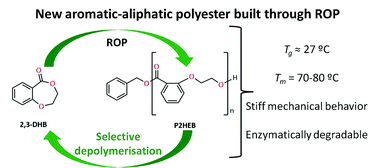Thermal, structural and degradation properties of an aromatic–aliphatic polyester built through ring-opening polymerisation†
Abstract
The novel biodegradable aromatic–aliphatic polyester, poly(2-(2-hydroxyethoxy)benzoate), was explored through thermal analysis, X-ray diffraction, dynamic mechanical analysis and comparative bio and catalysed degradation. The polyester is a product of ring opening polymerisation (ROP) of 2,3-dihydro-5H-1,4-benzodioxepin-5-one catalysed by an aluminium salen catalyst. Thermal and mechanical characterisation showed that the polyester had a Tg of nearly 27 °C and crystallisation ability when cooled from melt, providing insight into potential biomedical and compatibiliser applications. These thermal and mechanical properties can be tuned by altering the polymer's molecular weight. The crystal structure has also been determined through wide-angle X-ray diffraction (WAXD). The polymer can be enzymatically degraded, but this process is slow compared to the rapid degradation by exploiting the monomer–polymer equilibrium catalysed by the aforementioned aluminium salen complex.



 Please wait while we load your content...
Please wait while we load your content...